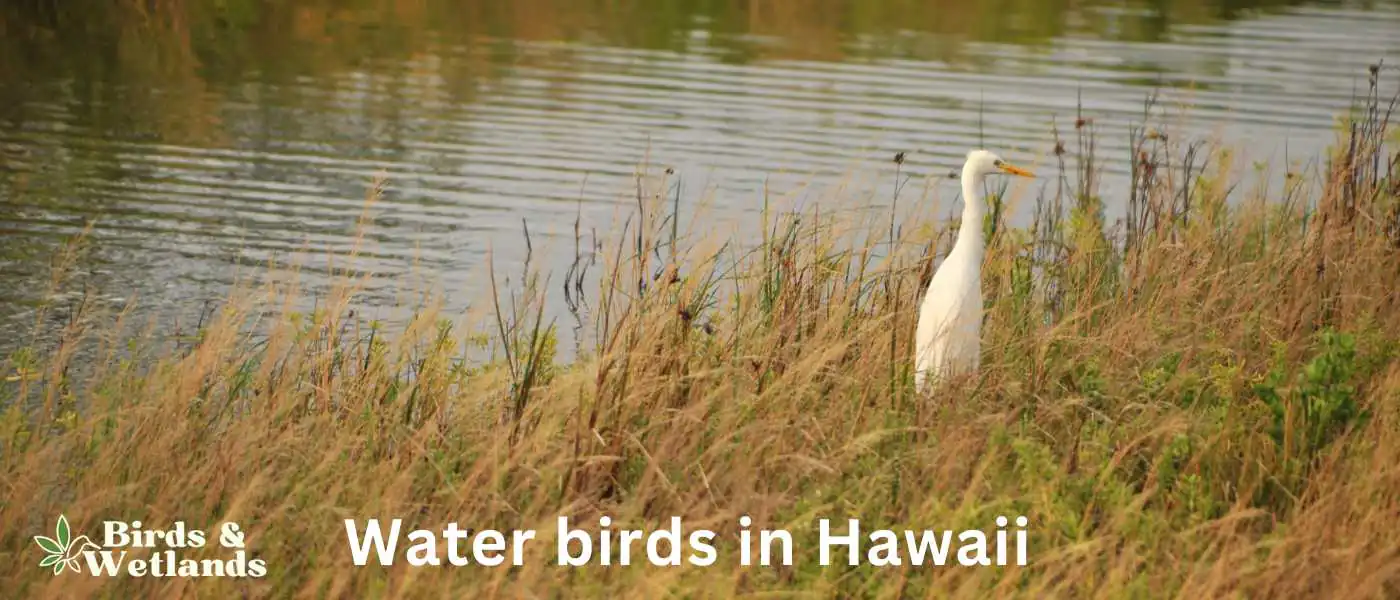Hawaii, known worldwide for its tropical paradise allure, is more than just beautiful beaches and verdant landscapes. This chain of islands in the Pacific is also a haven for an impressive variety of water birds. Hawaii’s unique combination of marine and freshwater habitats, along with its isolation from other landmasses, has given rise to a unique blend of water bird species.
Hawaii water birds
| Water Bird Species | Frequency in Hawaii | Where to Find in Hawaii |
|---|---|---|
| Hawaiian Duck (Koloa) | Common | Waimea Valley, Kauai’s Alaka’i Wilderness Preserve |
| Hawaiian Coot (Alae ke’oke’o) | Common | Wetlands and reservoirs across the islands |
| Hawaiian Stilt (Ae’o) | Common | Wetlands, especially Kealia Pond National Wildlife Refuge on Maui |
| Hawaiian Gallinule (Alae ‘ula) | Common | Freshwater wetlands, like those in Hamakua Marsh, Oahu |
| Pacific Golden-Plover (Kolea) | Very Common | Throughout the islands, especially in grassy areas and parks |
| Laysan Albatross | Common | Northwestern islands, especially Midway Atoll |
| Black-footed Albatross | Common | Northwestern islands, especially Midway Atoll |
| White Tern (Manu-o-Kū) | Common | Mainly on Oahu, especially around Honolulu |
| Red-footed Booby | Common | Northwestern islands and Kilauea Point, Kauai |
| Brown Booby | Common | Cliffs and islets, especially on Kauai and Oahu |
| Great Frigatebird | Common | All islands, but most common on Northwestern islands |
| Red-tailed Tropicbird | Common | Sea cliffs on Kauai and Maui |
| White-tailed Tropicbird | Common | Coastal cliffs on all islands |
| Sooty Tern | Common | Northwestern islands, especially Midway Atoll |
| Black Noddy | Common | Northwestern islands and sea cliffs on main islands |
| Brown Noddy | Common | Northwestern islands and islets off the main islands |
| Fairy Tern | Common | Forests and coastlines on all islands |
| Wedge-tailed Shearwater | Common | Throughout the islands, nesting in sandy areas |
| Christmas Shearwater | Common | Northwestern islands, especially Laysan Island |
| Newell’s Shearwater | Common | Mountainous regions of Kauai |
| Bulwer’s Petrel | Common | Northwestern islands |
| Bonin Petrel | Common | Northwestern islands |
| Red-billed Tropicbird | Common | Sea cliffs on all islands, especially Kauai |
| Band-rumped Storm-Petrel | Common | At sea, and mountainous regions of main islands for nesting |
| Hawaiian Petrel | Common | At sea, and mountainous regions of main islands for nesting |
Water Bird Species Found in Hawaii

Listen to Hawaiian Duck
The Hawaiian duck or Koloa, also known as the Hawaiian Mallard, is a species of bird that is endemic to Hawaii. They are unusual among other types of birds because they do not fly very often at all; instead, they prefer to stay near the water’s edge.
Their head and neck are bright yellows in color and they have a black bill with a large orange spot on it. They also have white-colored legs that match the color of their bill and feet. This helps them blend into their surroundings which helps them avoid predators while they’re swimming or diving for food in shallow waters.
Hawaiian Ducks, Hawaiian Goose (Nene), and Laysan Duck are the only species of waterfowl that can be found on all of the Hawaiian Islands. Hawaiian Ducks live in marshlands, freshwater ponds, streams, and lakes with plenty of covers such as tall grasses or reeds throughout Hawaii’s forests where there are plenty of insects for them to eat throughout the day while they’re resting at night.
There are currently around 10 million Hawaiian Ducks living throughout all eight major islands including Maui County on Oahu Island (Honolulu) where there’s an estimated population of around 1 million birds out there right now.
Scientific Name: Anas wyvilliana
Height:
Male:48–50 cm (19–19.5 in)
Female: 40–43 cm (15.5–17 in)
Wingspan: 97-114 cm (38-45 in)
Weight:
Male: 604 grams (21.3 ounces)
Female: 460 grams (16 ounces)
Hawaiian Coot (Fulica alai)

The Hawaiian Coot, or Alae-alae, is a unique bird that can be found in Hawaii. It has a unique appearance, and its habitat is limited to the islands of Hawaii.
- Scientific Name: Fulica alai
- Length: 33–40.6 cm (13–16 in)
- Wingspan: 23.0-25.0 in (58.4-63.5 cm)
- Weight: 700 g (1 lb 9 oz)
Hawaiian Coot Description
Hawaiian Coots have a distinctive white patch under their beak, which makes them easy to identify when they are flying overhead. They have brown backs and white chests with black markings on their wings and tails.
Unlike other coots, Hawaiian Coots have only two toes instead of four. They also have long legs that make them excellent swimmers.
The Hawaiian Coot is a fascinating bird that is endemic to the Hawaiian Islands.
Hawaiian Coot Sound
Hawaiian Coot Habitat & Range
The Hawaiian Coot can be found in wetland areas such as marshes, ponds and streams. They prefer shallow water with muddy bottoms and tall grasses to hide in.
The Hawaiian Coot is a bird that is found exclusively in the Hawaiian Islands. It is most commonly found on the island of Kaua’i, but it can also be found on O’ahu, Maui, and Moloka’i.
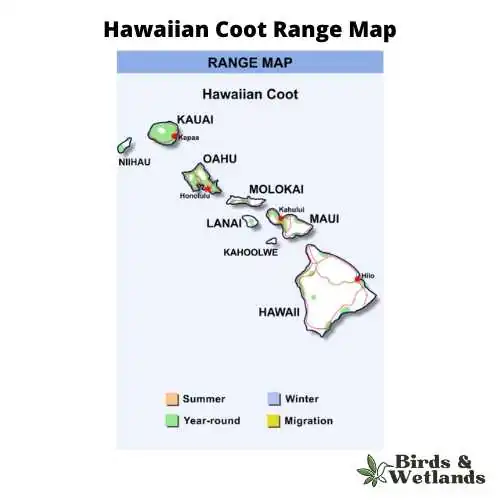
Hawaiian Coot Diet
The diet of these birds consists mostly of insects and small creatures that live on land or in water such as worms and mollusks. They also eat seeds found near bodies of water like rice fields or sugar cane plantations which grow along their habitat areas throughout Hawaii’s islands.
Hawaiian Coot Nesting
Hawaiian coot nests in wetland areas, such as marshes and swamps. It builds its nest out of reeds and grasses, which it weaves together with its beak. The coot lays six to eight eggs at a time, which it incubates for about two weeks.
/Hawaiian Stilt
/Hawaiian Gallinule

The Pacific Golden-Plover is a medium-sized shorebird that breeds in Alaska and Canada and the northern United States. They are known for their striking plumage of black, white, and chestnut.
- Scientific Name: Pluvialis fulva
- Length: 25 cm (9.8 in)
- Wingspan: 61 cm (24 in)
- Weight: 135 g (4.8 oz)
Pacific Golden-Plover Description
They have a long bill with a black tip and an orange base. Their legs are also orange. Their eyes are dark brown, and their feet are light gray or pale yellow, depending on the season. It has a distinctive appearance with black on its face, white on its belly, and brown on its back.
The population of this species is currently considered stable at around 150 million individuals worldwide, but they are still considered vulnerable due to their preference for areas that are often disturbed by human activity such as agriculture, urbanization, and tourism development projects.
Pacific Golden-Plover Sound
Pacific Golden-Plover Habitat & Range
The habitat of the Pacific Golden-Plover is primarily on rocky shores or sand bars near the water with sparse vegetation or grasses. They will also use mudflats, beaches, and dunes to nest. They can also be found on agricultural land and golf courses where water is available for bathing and drinking.

Pacific Golden-Plover Diet
The diet of the Pacific Golden-Plover includes insects such as flies and beetles, worms, mollusks such as clams and snails, crustaceans such as crabs and shrimp, spiders, millipedes, centipedes; plant matter including seeds from weeds like grasses and sedges; and berries including blueberries.
Pacific Golden-Plover Nesting
Pacific Golden-Plover nesting in small depressions in the ground, lined with grass and feathers. The female lays 3-4 eggs, which are incubated for around 21 days.
Laysan Albatross (Phoebastria immutabilis)

The Laysan Albatross is a Pacific bird, native to the ocean surrounding Hawaii, Japan and the Philippines.
- Scientific Name: Phoebastria immutabilis
- Length: 81 cm (32 in)
- Wingspan: 195 to 203 cm (77–80 in)
- Weight: Male: 2.4 to 4.1 kg (5.3–9.0 lb)/Female: 1.9 to 3.6 kg (4.2–7.9 lb)
Laysan Albatross Description
They have dark gray bodies and white underbellies. They have black heads with white patches above their eyes, on the back of their necks and on their cheeks. Their beaks are black and hooked, and they have gray legs. They also have white feathers around its neck and chest area.
Laysan Albatross Sound
Laysan Albatross Habitat & Range
Laysan albatrosses live in tropical areas around the world, including Hawaii, Japan, Mexico and Australia. They spend most of their time at sea, but return to land to nest on remote islands.
The Laysan Albatross lives in colonies that can number into the thousands. These colonies are located on small islands where they build nests out of grasses and twigs.

Laysan Albatross Diet
They eat fish like sardines, anchovies and squid; they also eat crustaceans like crabs and shrimp. They can dive up to 300 feet underwater! The birds fly long distances in search of food—sometimes flying as far as 1,000 miles each day.
Laysan Albatross Nesting
They may also use human-made structures such as roofs or fences for nesting sites if they are available in an area where there are no natural options available for them to choose from instead. They breed on islands all over the Pacific Ocean. The birds mate for life and raise one chick at a time every other year (sometimes three times in a row).
Black-footed Albatross (Phoebastria nigripes)


Listen
Scientific Name: Phoebastria nigripes
Length: 27 – 29 in
Wingspan: 6.2–7.2 ft
Weight: 5.7–9.5 lb
The Black-footed Albatross is a large seabird known for its exceptional flying and foraging skills, as well as its long-distance oceanic travels. They are capable of flying thousands of miles across the ocean to forage for food while expending very little energy, a trait known as dynamic soaring.
Appearance: Black-footed Albatrosses are notable for their overall dark plumage, which is brownish-black, contrasting with a white patch around the base of the bill and behind the eye. As their name suggests, they have dark feet. Their bill is large, pinkish, and hooked, well adapted for catching prey.
Diet: These albatrosses primarily feed on squid, but also eat fish and other marine invertebrates. They are known to follow ships to pick up scraps and are proficient divers, able to plunge into the ocean to capture their prey.
Reproduction: Black-footed Albatrosses nest on remote islands in the North Pacific Ocean, laying a single egg in a ground nest made of sand and vegetation.
The White Tern (Gygis alba)

The White Tern is a small tern with a relatively large wingspan. It is also one of the most common seabirds in North America.
- Scientific Name: Gygis alba
- Length: 28-33 cm
- Wingspan: 66-78 cm
- Weight: 100-140 g
White Tern Description
It has a black head, back and tail, gray-brown upperparts and pale gray underparts. The bill is orange with a black tip. The legs are pinkish red. The underside of their bodies are white with black stripes down their backs. They have yellow eyes, which makes them easy to spot when they fly overhead or dive for prey into the water below them.
White Tern Sound
White Tern Habitat & Range
White terns are migratory birds that breed on islands off the coasts of Florida and Maine during the summer months, and then migrate south to fly to warmer climates during the winter. They spend their winters in Mexico and Central America.

White Tern Diet
White Terns feed by plunge-diving for fish or squid, typically 60–120 meters below the surface of the water (but sometimes up to 200 meters). They may also pick up food items while swimming or hovering just above the water’s surface.
White Tern Nesting
The White Tern breeds in North America, Europe and Asia. It nests in colonies on islands or coastal cliffs, making its nest from seaweed and other plant materials. White terns are monogamous and return to the same breeding site each year.
It lays 2–3 eggs which both parents incubate for about one month before hatching which hatch after about 20 days. The young birds fledge in 30 days and remain with the adults for another 6–10 weeks before leaving to colonize their own territories.
Red-footed Booby (Sula sula)

The Red-footed Booby is a seabird that is found only in the Galapagos Islands. It is a member of the Sulidae family, which includes other boobies such as the Blue-footed Booby and Masked Booby. They are also known as Masked Booby and Peruvian Booby.
- Scientific Name: Sula sula
- Length: 70 cm (28 in)
- Wingspan: 152 cm (60 in)
- Weight: 837 g (1.845 lb)
Red-footed Booby Description
It has a short, thick neck and a rounded head with a black crown. Its bill is pinkish-red, but becomes bright red during the breeding season. Its back is dark brown with white spots on its upper wing, while its underparts are white with brown patches on the chest and belly. Its legs are long, red and webbed for swimming.
They are very social birds and often travel in large flocks, diving into the water to catch fish. They are also known for their elaborate courtship displays in which they fly high above the water and dive down at incredible speeds to impress potential mates.
Red-footed Booby Sound
Red-footed Booby Habitat & Range
The red-footed booby can be found in tropical paradise islands such as Hawaii or Fiji where they live on rocky coasts or sandy beaches at sea level to elevations of around 100 meters (300 feet).
They only live on remote islands where there aren’t many predators or other threats to their eggs or chicks. Red-footed Boobies can be found on islands throughout the Pacific Ocean and Indian Ocean.

Red-footed Booby Diet
The red-footed booby has a long beak that it uses for fishing, which it does by diving into the water from high up in the air. It eats small fish, squid, crustaceans, and other sea creatures.
Red-footed Booby Nesting
Red-footed Boobies are monogamous birds who pair up for life and mate for one season each year between April and June. They build nests out of sticks on cliff ledges or in trees above water sources such as lakes or ponds. The female lays two eggs at a time which both parents incubate for about three weeks until they hatch into chicks.
Brown Booby (Sula leucogaster)

The brown booby is a striking bird whose scientific name is Sula leucogaster. It is a member of the Sulidae family and is found in tropical and subtropical regions around the world. The brown booby is also known as the masked booby and the masked gannet.
- Scientific Name: Sula leucogaster
- Length: Male: 75 centimetres (30 in)/ Female: 80 centimetres (31 in)
- Wingspan: Male: 140 cm (4.6 ft)/ Female: 150 cm (4.9 ft)
- Weight: Male: 1,000 g (2.2 lb)/ Female: 1,300 g (2.9 lb)
Brown Booby Description
This large seabird has a white belly, dark brown back, and black head with white collar. The wings are dark grey with white tips on the feathers while its legs and feet are bright orange-red. Males are larger than females.
Brown Booby Sound
Brown Booby Habitat & Range
These birds are mostly found in tropical waters in the Pacific, Atlantic, and Indian oceans though they have been known to visit other regions as well. They can be found in many different types of habitats including coral reefs, mangrove swamps and lagoons.
They spend most of their time at sea except when they’re breeding or feeding their young—which is most often done by diving for fish or squid near coral reefs

Brown Booby Diet
The Brown Booby is an insectivore, meaning that it feeds on insects such as krill, plankton, and small fish. it is an opportunistic feeder that eats a variety of fish, crustaceans, squid, octopus, shrimp, jellyfish and mollusks. It will also consume small birds and mammals when available.
Brown Booby Nesting
These birds are generally solitary creatures and will only come together during mating season. They lay one egg per breeding season which takes about three months before hatching occurs (from May through September).
Great Frigatebird (Fregata minor)

The Great Frigatebird is a large seabird that can be found in tropical oceans around the world. It is also known as the “man-of-war bird” because it preys on smaller birds and steals their catches.
- Scientific Name: Fregata minor
- Length: 85 to 105 cm (33 to 41 in)
- Wingspan: 205–230 cm (81–91 in)
- Weight: Male: 1,000–1,450 g (2.20–3.20 lb) / Female: 1,215–1,590 g (2.679–3.505 lb)
Great Frigatebird Description
The Great Frigatebird has long, pointed wings and a deeply forked tail. Its head is blue and its body is black or brown. It has a red eye ring which may help keep out light from the sun’s glare.
The Great Frigatebird’s main predators are sharks, but they have ways of defending themselves against them. The bird will sometimes fall back on its tail to break its fall when diving into water after prey. This strategy deters sharks from following it down into deeper waters where they cannot breathe well enough to catch up with their prey.
Great Frigatebird Sound
Great Frigatebird Habitat & Range
The Great Frigatebird is found only in tropical regions of the Pacific Ocean and Indian Ocean. It lives on remote islands that are uninhabited by humans. The largest population being located in Australia.

Great Frigatebird Diet
The Great Frigatebird eats fish, squid, insects and crustaceans like crabs. It can drink salt water because its stomach has special glands for doing this. If it doesn’t have any food available when it needs it then it will drink sea water instead! This is why these birds live so far away from land.
Great Frigatebird Nesting
The Great Frigatebird nests in trees or on cliffs near the ocean. Its nest is made of sticks and other materials like seaweed and grasses that it finds on its island home. The male and female take turns sitting on their eggs while they hatch after about two weeks. The chicks leave their nest after about eight weeks but they continue to be fed by both parents until they are ready to fly at about 10 months old!
Red-tailed Tropicbird (Phaethon rubricauda)
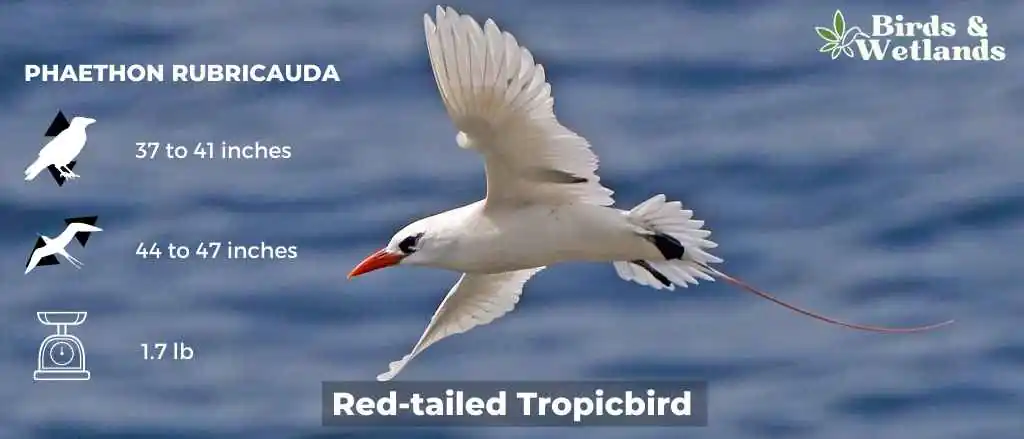
The Red-tailed Tropicbird is a tropical bird with a black bill, legs and feet. It has white plumage on its belly and breast, along with a red tail that gives it its name.
- Scientific Name: Phaethon rubricauda
- Length: 95 to 104 cm (37 to 41 in)
- Wingspan: 111 to 119 cm (44 to 47 in).
- Weight: 800 g (30 oz)
Red-tailed Tropicbird Description
The Red-tailed Tropicbird is also known for being one of the few birds that can fly backwards. Its body is black with a white belly, and it has a red tail. The head is black and white, with a red bill. The wings are long and narrow, with a sharp bend in the middle. The legs are short and pinkish-white in color.
Red-tailed Tropicbird Sound
Red-tailed Tropicbird Habitat & Range
It lives in coastal areas near the ocean, where it feeds on fish and squid.
It can be found throughout the tropical zones of the Pacific Ocean, except in Australia and New Zealand. These birds live on tropical islands such as Hawaii, Fiji, Samoa, Tahiti and other places within this area. They are also present in some parts of Asia such as Indonesia and Malaysia.

Red-tailed Tropicbird Diet
They feed on fish they catch while swimming under water using their long bills which are pointed at both ends like arrows so they can spear their prey easily before swallowing them whole. The diet of this bird changes depending on what is available during different seasons in its habitat.
Red-tailed Tropicbird Nesting
The nest of this bird is made from sticks that are lined with grasses or leaves from plants found on land or underwater. A single egg is laid by each pair during breeding season which lasts from March to June in Australia and New Zealand; these birds mate for life so if only one parent survives then both parents will raise their young together until they are old enough to leave home at about two years old.
White-tailed Tropicbird (Phaethon lepturus)
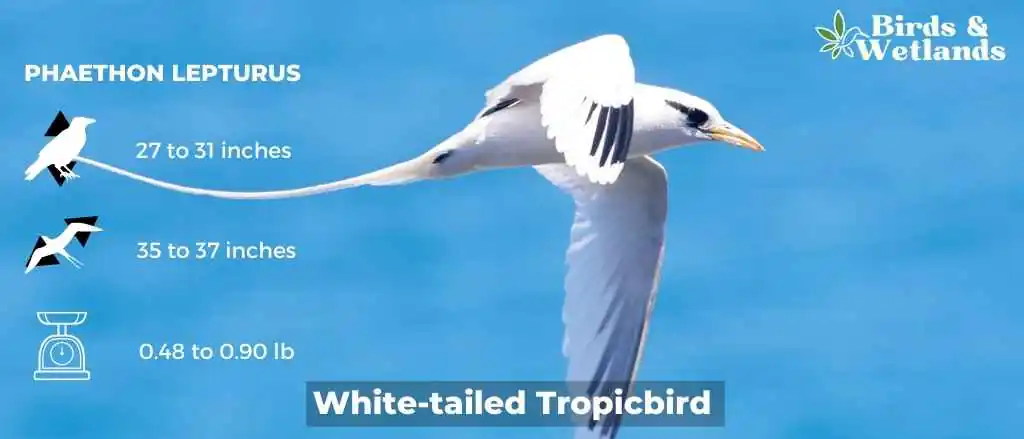
The White-tailed Tropicbird is a large seabird species of Phaethon lepturus, which means “white scallop.” It gets its name from the long tail that extends past its body when it flies, which looks like a white scallop shell in flight.
- Scientific Name: Phaethon lepturus
- Length: 71–80 cm
- Wingspan: 89–96 cm
- Weight: 220-410 g
White-tailed Tropicbird Description
The white-tailed tropicbird is a medium sized fish eating bird that has a very long tail that can be up to half as long as its body length. This species has a pale grayish blue plumage all over its body with a dark brown crown, nape, upper breast and rump. The tail is white with black tips and under tail coverts. It also has a red gular pouch which hangs down from its throat.
White-tailed Tropicbird Sound
White-tailed Tropicbird Habitat & Range
White-tailed Tropicbirds are found in tropical climates throughout the world’s oceans. They can be found in both warm waters near land and cooler waters further out at sea, as well as around islands such as Hawaii where they feed off fish eggs laid by other birds like boobies.

White-tailed Tropicbird Diet
White-tailed Tropicbirds are omnivorous, eating fish, squid and krill as well as some plants. They dive underwater to catch food, but also pick it up from the ocean surface.
White-tailed Tropicbird Nesting
The White-tailed Tropicbird nests in colonies on high cliffs or sea stacks off the coast of New Zealand and Australia. The nest consists of a single egg, which is incubated by both parents for about one month. The chick hatches after about two weeks, and fledges after three weeks.
This species is currently classified as Vulnerable by the IUCN Red List due to ongoing habitat loss from human activities such as fishing and farming.
Sooty Tern (Onychoprion fuscatus)

The Sooty Tern is a small sea bird that is native to Australia. It is one of three species in the genus Onychoprion.
- Scientific Name: Onychoprion fuscatus
- Length: 33–36 cm (13–14 in)
- Wingspan: 82–94 cm (32.5–37 in)
- Weight: 150 to 240 grams
Sooty Tern Description
This bird’s appearance is characterized by its black body, white face and wing tips, and a yellow bill. It has red eyes, which are located on either side of its head. It has long legs and large feet that allow it to perch on branches or small rocks in shallow water during feeding time.
Sooty Terns have a unique characteristic of being able to change their color depending on the background they’re against—if they’re sitting on a black rock, they turn black; if they’re sitting on white sand, they turn white. This helps them hide from predators while they’re nesting or feeding.
Sooty Tern Sound
Sooty Tern Habitat & Range
This bird prefers warm climates and inhabits coastal areas near bodies of water such as rivers or lakes during breeding season (between September and March). They can also be found in South America during this time period due to their nomadic nature when it comes to migration patterns.
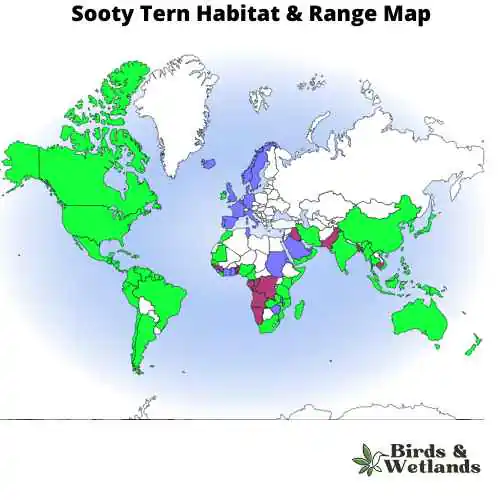
Sooty Tern Diet
The Sooty Tern feeds on small fish such as anchovies, sardines and herrings, squid, crustaceans including crabs, mollusks including mussels, insects such as flies and earthworms. It also eats algae growing on rocks at sea surfaces for nutrients needed for survival during breeding season.
Sooty Tern Nesting
The Sooty Tern nests on beaches or in the open sea near islands. The nest is made of seaweed strands or small pebbles, lined with finer material such as grasses and other plants. The eggs are pale blue to white, speckled with browns and blacks.
It has been classified as a vulnerable species by the IUCN, meaning that it is at risk of going extinct in the wild in the near future. The species is currently listed as critically endangered by BirdLife International, meaning that its numbers have decreased by more than 80% since 1980.
Black Noddy (Anous minutus)

The Black Noddy is a small, seabird that lives in Australia and New Zealand. They have black body and white belly. It has a distinctive red eye and black legs.
- Scientific Name: Anous minutus
- Length: 35–37 cm (14–15 in)
- Wingspan: 66–72 cm (26–28 in)
- Weight: 98–144 g (3.5–5.1 oz)
Black Noddy Description
It has a black head and body, with white feathers on its back and wings. Their feet are black, and they have bright orange beaks. It has a long, pointed bill, and its wings are narrow and pointed. The tail is also narrow and pointed.
Black Noddy Sound
Black Noddy Habitat & Range
The Black Noddy lives in tropical waters of the Atlantic Ocean, Pacific Ocean, and Indian Ocean. They are found in tropical waters, usually near coasts or islands. They live in large groups and can be seen flying high in the air, making loud calls. In the winter months, they migrate to warmer climates in the Northern Hemisphere.

Black Noddy Diet
The Black Noddy feeds on small fish, squid and crustaceans such as shrimp or krill, mall silver fish including anchovies and sardines. They have been known to eat jellyfish! They get most of their water from their food but will drink from pools if necessary. They also swallow air to help them float when diving for food in deeper waters than they would normally be able to reach on their own power alone (such as when hunting for crustaceans).
Black Noddy Nesting
Black Noddies build their nests on top of large trees, using sticks as building material for the structure. The female lays about two eggs per clutch, which both parents will incubate for about 24 days. After hatching, both parents feed the young birds until they are ready to leave the nest themselves at around 25 days old.
Brown Noddy (Anous stolidus)

Brown Noddies are a type of albatross that can be found in the Atlantic Ocean and the Indian Ocean.
- Scientific Name: Anous stolidus
- Length: 38–45 cm (15–18 in)
- Wingspan: 75–86 cm (30–34 in)
- Weight: 150 – 242 gr
Brown Noddy Description
Their unique characteristics include their black-and-white plumage, which can sometimes be confused with the similar-looking light-mantled sooty albatross. They have a dark brown plumage with a white belly, and their bills are orange-yellow. They have a brown eye stripe, and their feet are pinkish to pale grey. The female is slightly smaller than the male, but otherwise looks similar.
Brown Noddy Sound
Brown Noddy Habitat & Range
Brown Noddies live primarily in tropical regions and can be found in habitats such as coral reefs and grasslands. They breed in colonies on rocky cliffs and islands throughout their range.
They can be found in the Indian Ocean, including Australia and New Zealand.

Brown Noddy Diet
They have a varied diet that includes crustaceans, squid, octopus, fish, prawns or krill, and squid, which they catch by diving into the water from high altitudes above their prey. They also sometimes eat squid and jellyfish when available
Brown Noddy Nesting
Their nests are large balls of twigs, grasses, seaweed, and feathers that are built on the ground or low in trees.
Nesting occurs during the months of September through January, when females lay one egg per season. The population size of Brown Noddies is believed to remain stable due to their long life span (40 years) and low reproductive rate (one egg per year). Both parents take turns incubating them until they fledge at about ten days old.
/Fairy Tern
Wedge-tailed Shearwater (Ardenna pacifica)
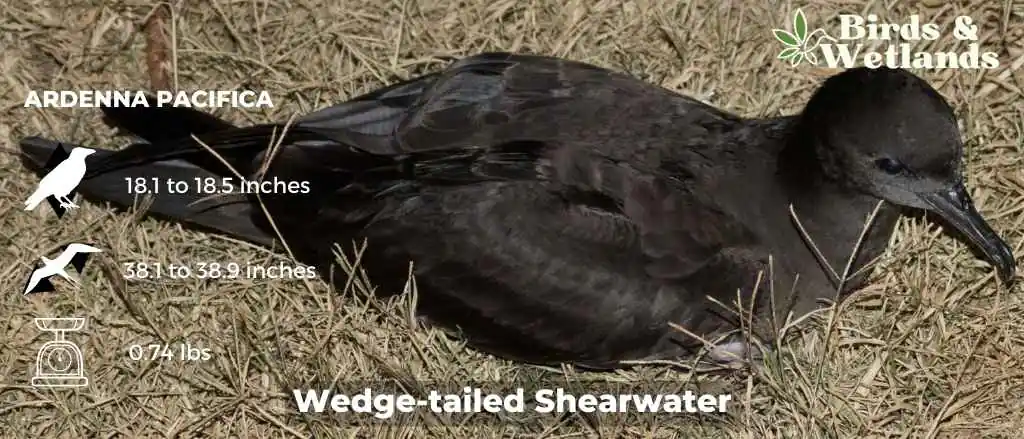
The Wedge-tailed Shearwater is a seabird that can be found in the South Pacific. They are easily recognized by their large, wedge-shaped tail.
- Scientific Name: Ardenna pacifica
- Length: 33 to 40 cm (13 to 15 inches)
- Wingspan: 40 inches
- Weight: 540 g (1 lb 2 oz)
Wedge-tailed Shearwater Description
The Wedge-tailed Shearwater is a large, dark-gray seabird that has long feet and a long tail with a white tip. The wedge-tailed shearwater has a pointed beak, sharp wings and a medium-sized body. It is a very distinct bird, with its black cap, white throat and white tail making it easy to identify.
Wedge-tailed Shearwater Sound
Wedge-tailed Shearwater Habitat & Range
They have been known to nest in areas such as New Zealand, Australia, Chile, and Tasmania. They are commonly seen at sea and on land around rocky coasts or in forested regions. The Wedge-tailed Shearwater can also be found near estuaries and inland lakes and ponds.
They are nomadic birds that migrate to warmer climates during winter months. They usually travel alone or in pairs during migration periods but they may form large flocks when they reach their breeding grounds during springtime (March through June).
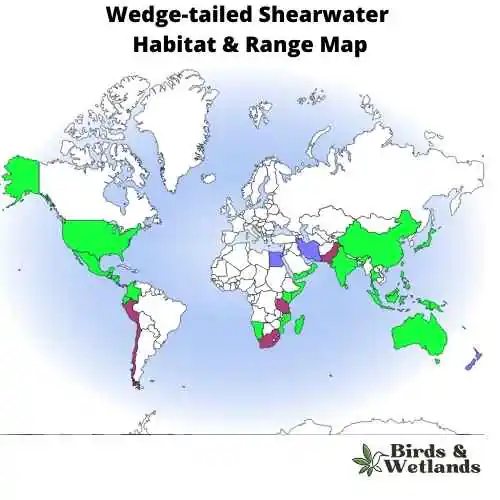
Wedge-tailed Shearwater Diet
They feed on small fish such as anchovies, sardines, mackerels and squid while they are in flight; they also eat crustaceans including krill which makes up over 90% of their diet when they are feeding young chicks (eggs) or themselves during breeding season (March through June).
Wedge-tailed Shearwater Nesting
It nests on islands off the Australian coast, including Lord Howe Island, Macquarie Island, and Tasmania. They nest in burrows or under shrubs or bushes.
Christmas Shearwater (Puffinus nativitatis)

The Christmas Shearwater, or Puffinus nativitatis, is a bird that lives on the island of New Zealand. This shearwater is named after its distinctive coloring: it has a white belly and black wings.
- Scientific Name: Puffinus nativitatis
- Length: 36 cm
- Wingspan: 75 cm
- Weight: 350 g
Christmas Shearwater Description
They are typically gray or white with black markings on their wings and tail feathers. Their bill is yellowish-green with a black tip. Males have a larger beak than females and tend to have more black coloration on the upper part of their body.
Christmas shearwaters are very agile flyers, capable of catching flying fish with ease. They also have excellent eyesight that allows them to spot prey from great distances in both air and water. They will often use this ability to hunt flying fish right after they’ve been caught by other predators such as dolphins or sharks. This allows them to eat their fill without having to compete for food with other animals that might be nearby
Christmas Shearwater Sound
Christmas Shearwater Habitat & Range
The Christmas shearwater is a medium-sized seabird that can be found in a wide range of habitats, including beaches and coastlines.
Christmas shearwaters are found throughout most of Australia’s southern waters, including Tasmania, New Zealand, and surrounding islands like Lord Howe Island (known for its incredible diving sites).

Christmas Shearwater Diet
This bird feeds primarily on squid and fish. It will dive up to 500 meters deep into the ocean to catch its prey but often returns to land after fishing trips because it cannot take off from water due to its small surface area wingspan (about 30 cm).
Christmas Shearwater Nesting
They nest in burrows, which are lined with grasses, leaves and feathers. They lay one egg per year, which they incubate for about 50 days before it hatches. Once the chick has hatched, it stays in the burrow for another two months before leaving to join other young birds in their first migration out to sea.
Newell’s Shearwater (Puffinus newelli)

The Newell’s Shearwater is a medium-sized seabird with a blackish-brown body and white underparts. This bird is a member of the Procellariidae family of seabirds, which includes shearwaters, fulmars, petrels and storm-petrels. It is often mistaken for the Buller’s Shearwater due to its similar size and coloration.
- Scientific Name: Puffinus newelli
- Length: 33 centimetres (13 in)
- Wingspan: 223–249 millimetres (8.8–9.8 in)
- Weight: 0.340–0.425 kilograms (0.75–0.94 lb)
Newell’s Shearwater Description
Newell’s Shearwater is a medium-sized shearwater with a long, slender bill, which makes it easy to identify. The plumage of Newell’s Shearwater varies depending on its age and sex, but they all have dark blue or black upperparts and white underparts.
Newell’s Shearwater Sound
Newell’s Shearwater Habitat & Range
Newell’s Shearwater can be found throughout the Pacific Ocean and Atlantic Ocean as far south as Chile. They are most commonly seen in coastal waters or flying over islands or open ocean away from land during their migrations.
This bird can be found in California, Mexico, Central America and South America, within tropical oceans (about 50 degrees North to 45 degrees South).
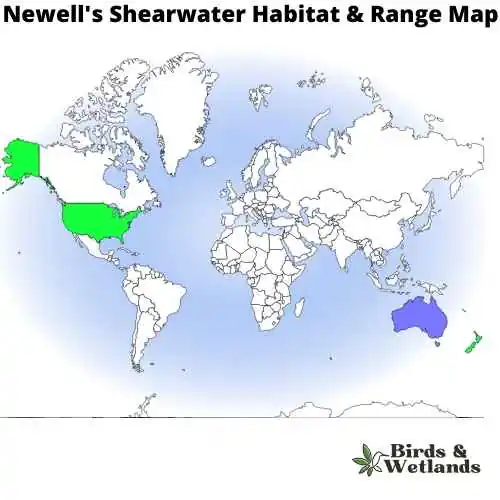
Newell’s Shearwater Diet
They feed on fish, squid, octopus and other crustaceans. They also feed on small fish such as capelin, anchovy, and sardine.
Newell’s Shearwater Nesting
Newell’s Shearwaters nest in burrows on rocky cliffs near the ocean or other bodies of water such as lakes or streams. They will also nest on bare ground if no rock surfaces are available nearby. The average clutch contains two eggs that hatch after about one month of incubation by both parents (which includes both male and female birds). Once hatched, chicks remain with their parents for about three months before learning how to fly.
/Bulwer’s Petrel
Bonin Petrel (Pterodroma hypoleuca)
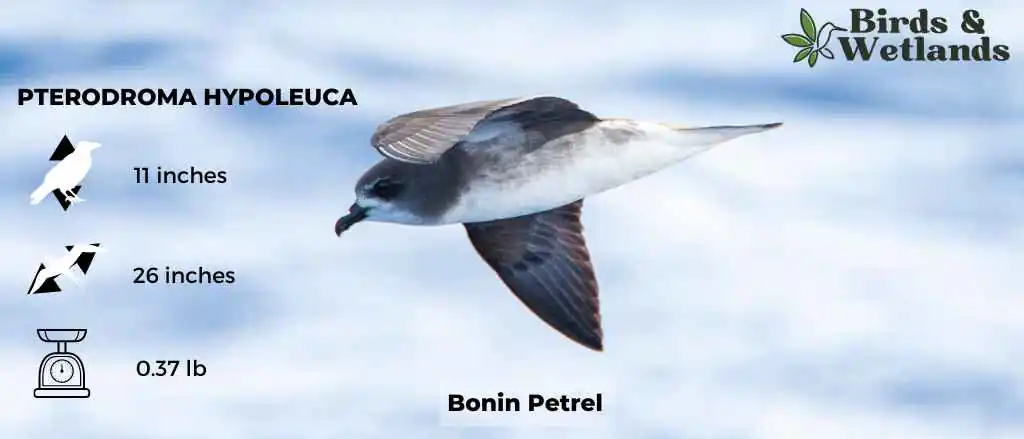
Bonin Petrel is a species of petrel that is found in the North Pacific Ocean. It is part of the Procellariidae family, which includes shearwaters and diving petrels.
- Scientific Name: Pterodroma hypoleuca
- Length: 30 cm
- Wingspan: 67 cm
- Weight: 170 g
Bonin Petrel Description
An adult Bonin Petrel has a dark grey back with a white rump and tail tips. The breast is mottled with black and white. The bill is red and legs are pinkish-grey. Its eyes are brown. Juveniles have dark brown or black upperparts with white spots on the underparts. The bill is yellowish-brown with a black tip and legs are pinkish-grey.
Bonin Petrel Sound
Bonin Petrel Habitat & Range
Bonin Petrels can be found throughout the Bonin Islands, which includes Iwo Jima and Chichijima among others. The Bonin Petrel is an oceanic bird that is rarely seen on land; it spends most of its time at sea hunting for food. The habitat of this bird includes remote oceanic islands, as well as rocky cliffs and grassy slopes on small islands.
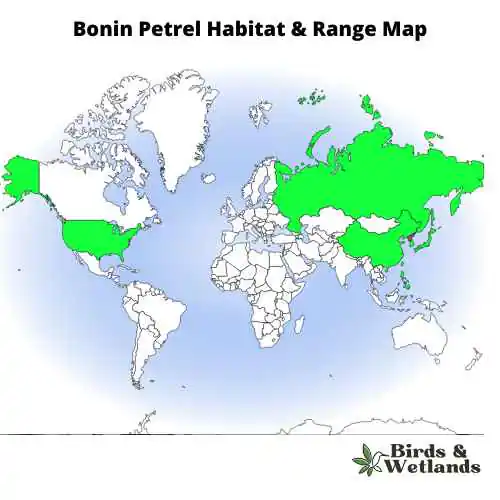
Bonin Petrel range map credit https://www.oiseaux.net/
Bonin Petrel Diet
They can be found feeding over the sea at night where they eat small fish such as anchovies or sardines. They also eat squid, shrimps and crustaceans such as krill.
Bonin Petrel Nesting
The nest of the Bonin Petrel is made from grasses and mosses and lined with feathers from other birds such as cormorants or boobies. The female lays two eggs per clutch (brood), which incubate for about 30 days before hatching. Once hatched, both parents take turns sitting on them until they fledge at about 60 days old (become independent).
Red-billed Tropicbird (Phaethon aethereus)

Red-billed Tropicbird is a beautiful, tropical bird that lives on the Galapagos Islands. It’s best known for its large red beak and black body.
- Scientific Name: Phaethon aethereus
- Length: 90 to 105 cm (35 to 41 in)
- Wingspan: 99 to 106 cm (39 to 42 in)
- Weight: 420 g
Red-billed Tropicbird Description
The Red-billed Tropicbird has a black head and neck with a white throat and belly. Its back is dark brown, and its wings are pale brown in color. The lower portion of the wing has a black stripe across it, while the upper portion has white stripes running down the center. The tail feathers are blue-gray with white tips on them.
Red-billed Tropicbird Sound
Red-billed Tropicbird Habitat & Range
Red-billed Tropicbirds are found in tropical and subtropical waters around the world, including the Pacific Ocean and Indian Ocean. These birds tend to live in small groups in warm climates, although they can be found as far north as South Africa and as far south as Australia.
They spend most of their time at sea level but will occasionally fly higher up into the air if they feel threatened by predators

Red-billed Tropicbird Diet
Red-billed Tropicbirds eat fish, squid, krill, crabs and shrimp. They dive into the water after prey at high speeds and can remain underwater for up to 30 seconds before coming up for air.
Red-billed Tropicbird Nesting
The Red-billed Tropicbird is the only species of tropicbird that nests in New Zealand, but they do not breed on land. Instead, they lay their eggs on bare branches or trees high above the ground, so they are safe from predators. The chicks leave their nests after about 3 weeks and can fly within 2 weeks of hatching.
They prefer to nest on small islands or rocky outcroppings with few predators nearby so that they can keep an eye on their young
Band-rumped Storm-Petrel (Hydrobates castro)

Band-rumped Storm-Petrel
The bird’s name comes from its black rump patch, which is only visible when it flies.
- Scientific Name: Hydrobates castro
- Length: 19–21 cm
- Wingspan: 43–46 cm
- Weight: 44–49 g
Band-rumped Storm-Petrel Description
The Band-rumped Storm-Petrel is a small, dark brown seabird with white streaks on their wings. They have long, pointed wings and a rounded tail which they use to skim over the water in search of food. Their body is dark brown or black with a white belly, and their wings are white with black tips.
Band-rumped Storm-Petrel Sound
Band-rumped Storm-Petrel Habitat & Range
The Band-rumped Storm-Petrel can be found throughout the world’s oceans, though you may need to look closely to find them. These tiny birds live on remote islands and travel long distances to feed at sea. They are rarely seen except during migration or when they gather at breeding grounds.
It lives in the Southern Hemisphere in southern Australia, South Africa, New Zealand, and Argentina. It breeds on rocky islands off these coasts from December to May.
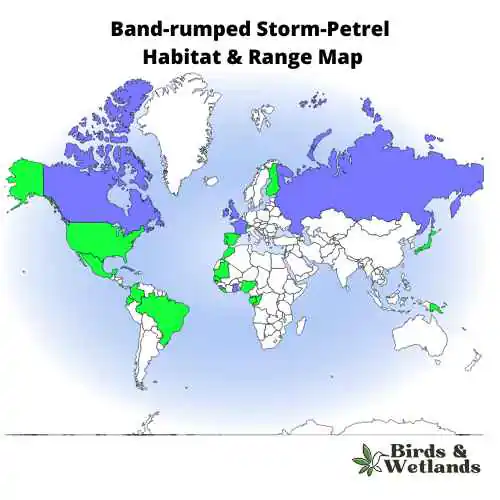
Band-rumped Storm-Petrel range map credit https://www.oiseaux.net/
Band-rumped Storm-Petrel Diet
They feed on small fish, squid and crustaceans that they find by skimming over the surface of the water or diving under it to catch prey with their bills. They also eat insects such as dragonflies and beetles when available. They also eat plankton and krill that they filter through their feathers while swimming.
Band-rumped Storm-Petrel Nesting
Band-rumped Storm-Petrels nest in large colonies on remote islands throughout the Pacific Ocean. The female lays one egg per nest site, which she incubates for 22 days before it hatches into a fluffy white chick with black eyes. The chicks leave the nest when they are about two weeks old, but they still depend on their parents for food for another month after that.
Hawaiian Petrel (Pterodroma sandwichensis)

Hawaiian Petrel
The Hawaiian Petrel is a species of seabird native to Hawaii. It is a member of the gadfly petrel family, Procellariidae, and is also known as the Hawaiian Gull-billed Petrel or Toroa.
- Scientific Name: Pterodroma sandwichensis
- Length: 16 inches
- Wingspan: 36 inches (91 cm)
- Weight: 15.3 oz (433.7 g)
Hawaiian Petrel Description
It has a brownish-grey body and wings, with white streaks on the underwing. The underparts are white, while the tail is black with white tips. The head is almost bald, with a short fringe of white feathers around the eye.
Hawaiian Petrel Sound
Hawaiian Petrel Habitat & Range
The Hawaiian Petrel is a small seabird that can be found on the Hawaiian archipelago. It lives in coastal waters of the Pacific Ocean, including those off the coast of Hawaii.
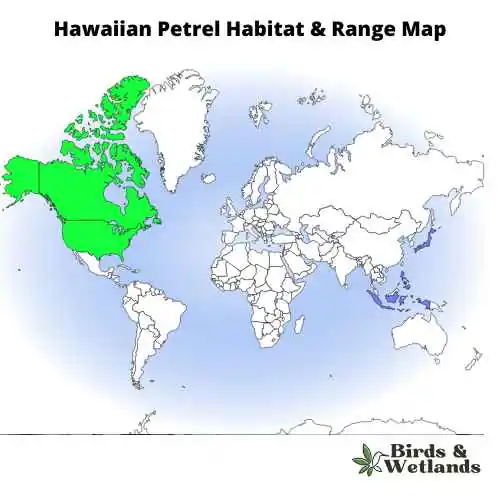
Hawaiian Petrel range map credit https://www.oiseaux.net/
Hawaiian Petrel Diet
Their diet consists mostly of squid, octopus, shrimp and other crustaceans; however they will also eat fish if they can catch them. The bird spends most of its time at sea where it dives for food as deep as 200 meters below the surface of the ocean.
Hawaiian Petrel Nesting
It nests on steep cliffs or in deep caves at sea level. The female lays just one egg each year and incubates it for about 70 days before hatching. The parents take turns sitting on their chick for up to one month after it hatches until it is able to fly away from home alone. The young fledge after about 4 months but do not leave their parents until they are fully grown at around 2 years old.
These birds are either endemic, native, or migratory species in Hawaii. The Hawaiian Islands are home to a diverse range of water bird species due to their unique location in the middle of the Pacific Ocean. As always, respect wildlife and their habitats during your birdwatching adventures.
Where to Spot Hawaii’s Water Birds
Kealia Pond National Wildlife Refuge, Maui: This coastal saline pond is one of the few natural wetlands left in the Hawaiian Islands, making it a vital sanctuary for many of Hawaii’s endemic and migratory water birds, like the Hawaiian Stilt and Hawaiian Coot.
Hanalei National Wildlife Refuge, Kauai: Nestled in the Hanalei Valley, this refuge is home to several endangered water birds such as the Hawaiian Duck, Hawaiian Moorhen, and Hawaiian Stilt. The taro field habitats are particularly important for these species.
Kilauea Point National Wildlife Refuge, Kauai: This refuge is an excellent place for spotting seabirds. Species such as the Red-footed Booby, Great Frigatebird, and the endangered Hawaiian Petrel can be observed here.
Hawaii Volcanoes National Park, Big Island: While best known for its volcanic landscapes, this national park also hosts a variety of water bird species in its various aquatic habitats, including the Kolea (Pacific Golden Plover) and Ae’o (Hawaiian Stilt).
Kawainui Marsh, Oahu: As the largest wetlands in Hawaii, Kawainui Marsh is an important habitat for water birds. Endemic species such as the Hawaiian Stilt, Hawaiian Coot, and Hawaiian Duck can be regularly spotted here.
FAQS on Waterbirds in Hawaii
Are there any endangered hawaiian waterbirds?
Yes, Hawaii is home to several species of endangered waterbird species. Due to the isolation of the main hawaiian islands, many species evolved there that are found nowhere else on Earth. However, the unique ecosystems of the islands have also been heavily impacted by human activity, leading to endangerment for many species. conservation efforts are under away and the usfws waterbird recovery plan aims to put these endemic waterbirds on a stronger footing going dowards.
The hawaiian duck koloa duck, hawaiian coot alae, Hawaiian Common Gallinule or ‘Alae’ula, hawaiian common moorhen, Hawaiian sti

